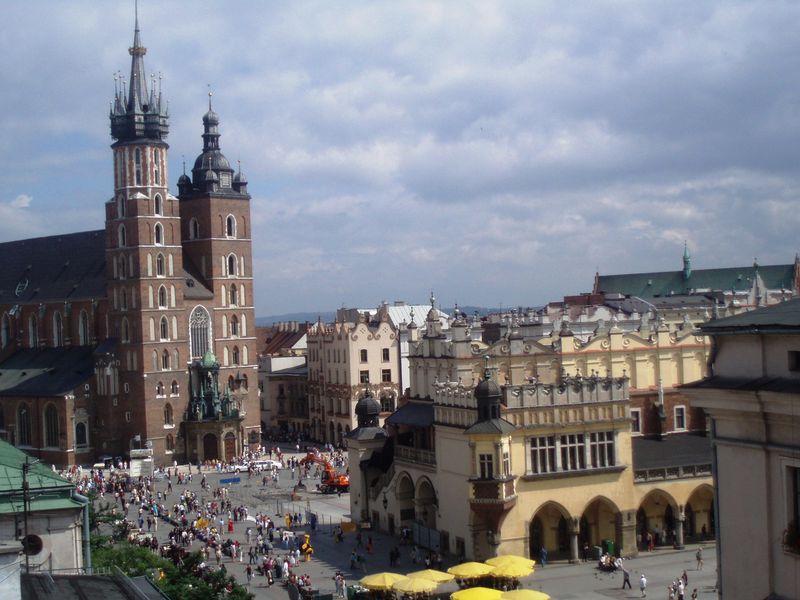 After a surprisingly hot day, we’ve had a big storm here in Krakow. My hotel room lies on the top (4th) floor, tucked under the eaves. Outside my window stretch the rooftops of Old Town and, not far in the distance, the famous tower of St. Mary’s Church.
After a surprisingly hot day, we’ve had a big storm here in Krakow. My hotel room lies on the top (4th) floor, tucked under the eaves. Outside my window stretch the rooftops of Old Town and, not far in the distance, the famous tower of St. Mary’s Church.
The church’s fame rests on a number of things, including its spectacular wood-carved altar piece. But more influential in shaping the public character of Krakow happens to be an event that takes place in the church’s tower: the trumpeter.
Yes, the famous “Trumpeter of Krakow.” (Perhaps you’ve seen the children’s book The Trumpeter of Krakow, a fictional work first published in 1928). The 13th-century legend tells of a trumpeter placed on watch to warn the besieged town of approaching Mongol troops. He spotted the enemy and began to play a tune to signal danger. What tune? Well, arguably the one still played today known as Hejnał Mariacki (St. Mary’s Dawn), although it can never be proved.
We sometimes forget that wind and percussion instruments were early warning systems in historical times. The blare of a trumpet or clang of a gong could travel long distances to alert a commander of approaching danger. In this case, the tune played by the long-ago trumpeter was cut short, says the legend, by an arrow to the poor chap’s throat.
Whether true or not, the legend’s power is such that every time, every single time, the tune is sounded from St. Mary’s tower, it is rendered in such a way as to be cut off abruptly, mid-stream, with a kind of trumpet gasp.
Now when I say “every time,” I’m not joking. Because this tune is sounded four times at the top of each hour. First the trumpeter rings the hour on the tower bells. A few seconds pass. Then, if you’re within one or two kilometers of the square, you will hear the strains of the melody.
The trumpeters today play in a specially constructed area that includes a place for a limited number of viewers (tower-climbers) and a resting area for the trumpeters. There are a number of selected musicians who share the 24 hour/365 day shifts. It is a great honor to become one of the trumpeters who opens a window on each side of the tower (north, west, south, east) and plays this tune, once in each direction!
Below, on the square, tourists and even locals stop to listen, applaud, or even cheer. Often they return the brisk wave the trumpeter gives upon completing each strain before snapping the window closed and turning to play in a new direction.
You can see in this video just how it looks from the perspective of the trumpeter. Considering how beautiful Krakow’s massive square is, especially in summer when filled with flower vendors, or during the Christmas Market when snow adds extra radiance, you can imagine that the trumpeters never tire of the spectacle.
But, of course, it is a job. Still, what a job! Can you imagine the job description? “Trumpeter needed to devote years to perpetuating an extraordinary musical and cultural tradition, one with enormous significance both to the people of Krakow and to the Polish nation. Not too many pitches required but intonation must be perfect.” And, for that matter, trumpeters approach this short tune with certain individual differences, as you will here if you sample a second video.
We’re extremely lucky on our Smithsonian Journey’s tours to stay in hotels along Floriansky Street, just off the square. That means I can hear the trumpeter from whatever room I occupy, no matter which tour. Do I tire of it? Never. If I wake in the middle of the night, and it’s the top of the hour, I hear the tune. While getting ready to go down for breakfast at 6, 7, or 8, I hear the tune. Walking around the square, I hear the tune. It’s marvelous.
The rain is really pouring now. But it’s 3 minutes until 9 p.m. and the trumpeter is up there. He’s standing at the window, warming up the mouthpiece. The blast of rain may block out this iteration but in a few hours the storm should pass. The midnight melody should be crystal clear. I’ll be eager to hear it.



